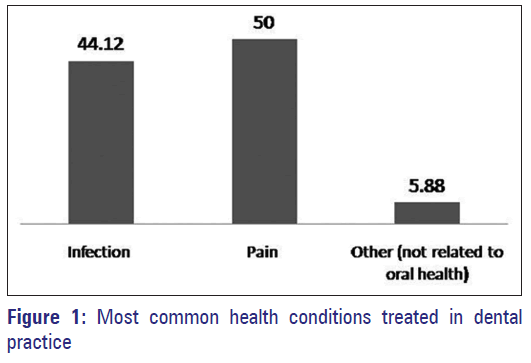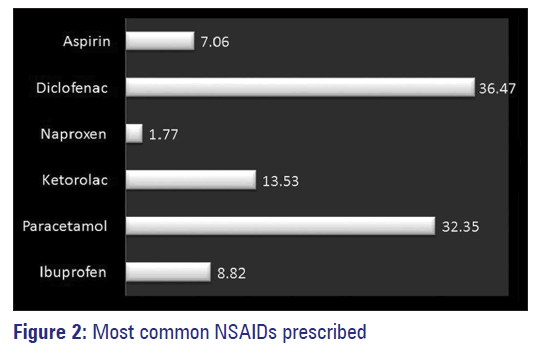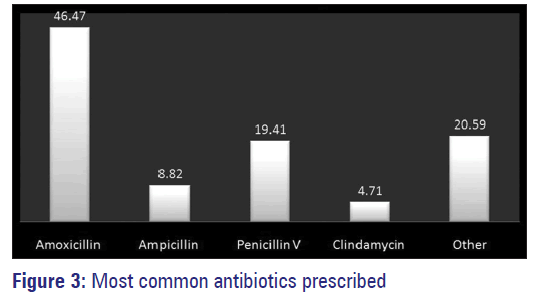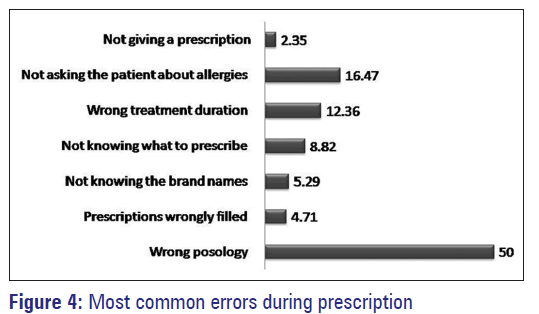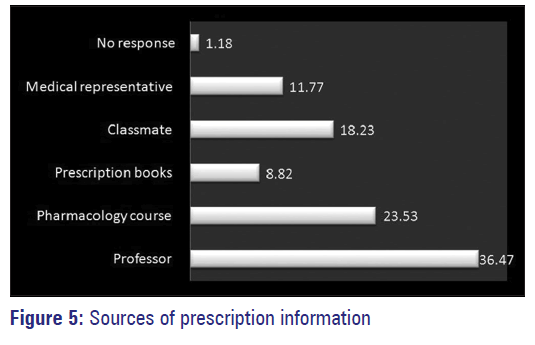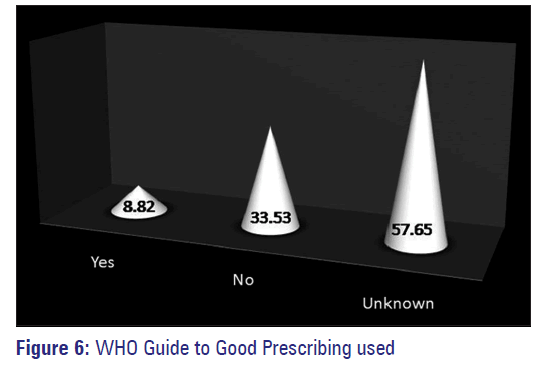Knowledge regarding prescription of drugs among dental students: A descriptive study
- *Corresponding Author:
- Dr. Ankita Jain
Department of Public Health Dentistry, Teerthanker Mahaveer Dental College and Research Centre, Moradabad, Uttar Pradesh, India.
E-mail: ankitajain.0815@gmail.com
This is an open access article distributed under the terms of the Creative Commons Attribution-Non Commercial-Share Alike 3.0 License, which allows others to remix, tweak, and build upon the work non-commercially, as long as the author is credited and the new creations are licensed under the identical terms.
Abstract
Introduction: The act of indicating one or more drugs to be taken by the patient, its dosage, and the interval of the treatment is known as prescribing. It is a dynamic and individualized clinical process. Cultural, social, economic and promotional factors can influence the pattern of prescription. Thus the present study was conducted to evaluate the drug prescription knowledge in third year and final year dental students at Teerthanker Mahaveer Dental College and Research Centre, Moradabad, Uttar Pradesh, India. Methodology: A questionnaire consisting of 10 open‑ended questions was used in a study which was conducted among 170 male and female, third year and final year dental students of Teerthanker Mahaveer Dental College and Research Centre. Tables and graphs were used to represent data. Results: Pain was found to be the most important reason for prescribing medication. Diclofenac was found to be the most commonly prescribed NSAID. While amoxicillin was found to be the most widely prescribed antibiotic. Lack of knowledge about drug posology was the basic reason for error done by students. Maximum number of students gets their information for prescribing drugs from their professors. Maximum number of students was unacquainted about the WHO Guide to Good Prescribing. Conclusion: The knowledge of prescribing drugs is of utmost need for good dental practice and hence, it is essential to expand the knowledge related to pharmacological therapy and to know about the proper therapeutic guidelines. With the help of WHO Guide to Good Prescribing, and some educational programs students will develop better prescribing skills.
Keywords
Dental students, drug, knowledge, prescription
Introduction
Drug therapy is the main tool that doctors have for influencing the health of their patients. As these drugs can offer great benefits to patients, they can also cause great harm. Prescribing is the primary intervention that most doctors offer to influence their patients’ health – whatever career medical graduates decide to pursue, most will have to remain ‘specialists’ in drug prescribing. [1] Most juni or doctors are unaware of the fact that prescribing errors may contribute to a significant rise in reported hospital adverse events and subsequent medico-legal problems. Unwise prescribing may assume several forms i.e., under, inappropriate, over, irrational and other prescribing errors. [2]
Prescribing is an individualized and dynamic clinical process. It is the act of indicating one or more drugs to be administered to or taken by the patient, drug dose, and the duration of the treatment. The prescription patterns may be influenced by social, cultural, economic, and/or promotional factors. [3] Improving the quality of dental prescriptions will reduce the risks for medication errors and will promote the rational use of pharmacotherapy, and patient safety. [4,5]
Rational drug prescription is defined as using the least number of drugs to obtain the best possible effect in the shortest period and at a reasonable cost. [6,7] Medical students and interns should be periodically assessed on prescribing knowledge and skills during their training as a means of minimizing prescribing errors. [8,9,10] A firm grounding in the principles of prescribing and therapeutics, an understanding of how drugs work, and a basic knowledge about commonly used drugs are essential for all medical graduates. [1] The most prescribed drugs in dentistry are the local anesthetics used during dental procedures, NSAIDs and antibiotics. Because of the characteristics of these drugs, it is mandatory to determine accurate doses and be aware of any adverse or toxic effects. [3] These drugs may cause harm to the patient if not prescribed properly. [11] Thus, knowledge of Pharmacology is most important component of undergraduate teaching curriculum where students learn about the art of prescription writing and different drug formulations. [2]
Hence, the present study was undertaken to assess the prescribing skill of third and final year student of bachelor of dental surgery (BDS) as the students starts their clinical work from third year onward.
Methodology
The present cross sectional study was carried out to assess the knowledge related to drug prescription awareness using a self-administered questionnaire with ten open-ended questions. The questionnaire was semi-structured and pre-tested to check the validity.
Ethical clearance
Before the commencement of study, the protocol was approved by the Ethical clearance Committee of Teerthanker Mahaveer University, Moradabad.
Informed consent
Informed consent was taken from the participants before their participation in the study in order to prevent any inconvenience and to ensure full co-operation.
Study Instrument
A self-administered questionnaire with ten open-ended questions was used to determine the knowledge related to drug prescription awareness among the dental students. The questionnaire was semi-structured and pre-tested to check the validity and reliability. The pre-testing of the questionnaire was done by running a pilot test on 30 students. Some of the questions were added, some of them were removed and some were reframed for the development of final questionnaire. The result of the pilot study was evaluated and a reliability coefficient (α) of 0.80 or more was considered adequate. The result of pilot study was not included in the main study.
For the main study rest of the 170 (both girls and boys) third year and final-year students were considered and the questionnaire was given to them. The study was conducted at the Teerthanker Mahaveer Dental College and Research Centre, Moradabad, Uttar Pradesh, India.
Data analysis Statistical analysis was conducted using SPSS 17.
Results
A total of 170 third year and final year students, both girls and boys participated in study [Table 1].
| Question | N | % |
|---|---|---|
| Most common health conditions treated in dental | ||
| practice | ||
| Infection | 75 | 44.12 |
| Pain | 85 | 50 |
| Other (not related to oral health) | 10 | 5.88 |
| Most common NSAIDs prescribed | ||
| Ibuprofen | 15 | 8.82 |
| Paracetamol | 55 | 32.35 |
| Ketorolac | 23 | 13.53 |
| Naproxen | 3 | 1.77 |
| Diclofenac | 62 | 36.47 |
| Aspirin | 12 | 7.06 |
| Most common antibiotics prescribed | ||
| Amoxicillin | 79 | 46.47 |
| Ampicillin | 15 | 8.82 |
| Penicillin V | 33 | 19.41 |
| Clindamycin | 8 | 4.71 |
| Other | 35 | 20.59 |
| Most common error during prescription | ||
| Wrong posology | 85 | 50 |
| Prescriptions wrongly filled | 8 | 4.71 |
| Not knowing the brand names | 9 | 5.29 |
| Not knowing what to prescribe | 15 | 8.82 |
| Wrong treatment duration | 21 | 12.36 |
| Not asking the patient about allergies | 28 | 16.47 |
| Not giving a prescription | 4 | 2.35 |
| Sources of prescription information | ||
| Professor | 62 | 36.47 |
| Pharmacology course | 40 | 23.53 |
| Prescription books | 15 | 8.82 |
| Classmate | 31 | 18.23 |
| Medical representative | 20 | 11.77 |
| No response | 2 | 1.18 |
| WHO guide to good prescribing used | ||
| Yes | 15 | 8.82 |
| No | 57 | 33.53 |
| Unknown | 98 | 57.65 |
| Knowledge about dose of drug prescribed | ||
| Yes | 95 | 55.88 |
| No | 70 | 41.18 |
| Unknown | 5 | 2.94 |
| Frequency of drug to be prescribed | ||
| Yes | 101 | 59.41 |
| No | 66 | 38.82 |
| Unknown | 3 | 1.77 |
| Knowledge of duration for which drug has to be prescribed | ||
| Yes | 102 | 60 |
| No | 65 | 38.23 |
| Unknown | 3 | 1.77 |
| Knowledge about route of drug administration | ||
| Yes | 112 | 65.88 |
| No | 57 | 33.53 |
| Unknown | 1 | 0.59 |
Table I: Number and percentages of answers given by students
Most common health conditions treated in dental practice
To this question majority of respondents answered pain (50%) as the main reason for prescribing medication followed by infection (44.12%) and the rest 5.88% answered some other reason for which they prescribe self medication [Figure 1].
Most common NSAIDs prescribed
The most common NSAID prescribed was Diclofenac (36.47%). 32.35% of students prescribe Paracetamol for pain relief. Ketorolac was prescribed by 13.53% students. Ibuprofen, Aspirin and Naproxen was prescribed by 8.82%, 7.06% and 1.77% respectively [Figure 2].
Most common Antibiotics prescribed
Maximum number of students (46.47%) prescribed Amoxicillin for majority of infections. Penicillin V, Ampicillin and Clindamycin was prescribed by 19.41%, 8.82%, 4.71% respectively [Figure 3].
Most common error during prescription
50% of students did error during prescription due to wrong posology. 16.47% did mistakes as they don’t ask for allergies in patients. 12.36% prescribe medications for wrong duration. 8.82%, 5.29%, 4.71%, 2.35% did error due to not knowing what to prescribe, not knowing the brand names, Prescriptions wrongly filled, not knowing the brand names, not giving a prescription respectively [Figure 4].
Sources of prescription information
36.47% students seek information for prescription from professor. Followed by 23.53% from Pharmacology course. 18.23% get information from classmates. Medical representative, Prescription books and no response were 11.77%, 8.82%, 1.18% respectively [Figure 5].
WHO Guide to Good Prescribing used
57.65% answered that they don’t know about this book, 33.53% answered that they don’t use that book and the remaining students said that they use that book [Figure 6].
Knowledge about dose of Drug Prescribed
55.88% of the students that they know about the dose to be given to the patient while 41.18% does not know and 2.94% students were unknown that doses of drugs also differ.
Frequency of Drug to be prescribed
59.41% of students answered that they know how many times the drug had to be prescribed while 38.82% doesnot know the frequency of drug to be given and 1.77% were unknown about the frequency.
Knowledge of Duration for which drug has to be prescribed
60% of the students knows for how long the drug had to be given while 38.23% of the students doesnot know the drug duration and 1.77% were unknown about duration of drug to be given.
Knowledge about route of Drug Delivery
65.88% of the students knows about the route of druf administration while 33.53% of the students doesnot know about the route of drug delivery and 0.59% of students were unknown about the route of drug administration.
Discussion
As per Dental Council of India, Students in their second year Bachelor of Dental Surgery attain pharmacology course that includes prescribing and knowledge regarding pharmacology and pharmacokinetics. It is the institution and the faculty responsibility to aware and educate students to become highly skilled in their professional practice. Students were not entirely answerable for prescribing as they prescribe under the guidance of seniors.
The most common health conditions treated in dental practice in the present study is pain which is in contrast with the study conducted by Guzmán-Álvarez et al. in which the most frequent reason for prescription is infection. Infection should always be treated as it leads to pain. To know the type and the origin of the pain appropriate diagnostic procedure should be used is very essential so that suitable treatment can be implemented. [3,12]
To be familiar with the pharmacokinetics and pharmacodynamics of all NSAIDs is the most essential aspect for their suitable use as well as the general properties that they share and the small differences between drugs. [12] Majority of students have the habit of prescribing diclofenac and paracetamol (36.47% and 32.35% respectively) which is in contrast with the previous studies in which ibuprofen was prescribed by maximum students. [3] Paracetamol can be prescribed alone but it has less anti-inflammatory properties. However, it is the only NSAID that possibly will be prescribed in amalgamation with other NSAIDs. [13,14] 13.53% of the students mentioned ketorolac as their first preference; Even though ketorolac is an exceptional analgesic, but it is not as efficient as an anti-inflammatory, it is potentially nephrotoxic as well as enormously irritates the stomach thus, it ought to be administered for not more than 5 days, and the patient be required to drink abundance of water to guard the kidneys. 1.77% and 7.06% of students prescribe Naproxen and aspirin which is in contrast with previous studies. [3,15]
Amoxicillin offset the result with 46.47%. since it is the first choice in dentistry so prescribed by maximum number of students (79) in dentistry. [17-22]
Wrong drug posology (50%) was the most frequent prescription error done by students which is in total agreement with previous studies. This is a serious issue, in view of the fact that it affects patient health and safety. Not knowing what to prescribe, Not knowing brand names, Improperly filled out prescriptions is a common problem and in addition compromises patient safety. without asking about patients allergies, wrong duration of administration will unquestionably lead to therapeutic failure and this could worsen the patient’s condition and may result in toxicity. [18] To avoid the problem of not knowing brand names, the WHO Guide to Good Prescribing recommends making a customized list including the essential drugs for each healthcare professional who prescribes drugs at the clinic. [19-21]
Most of the students (36.47%) gather their information for prescribing from their professors which is in agreement with previous study [3], To acquire information from professors is good as this is stage of the student’s development but it is enormously troubling that approximately 18.23% students still rely on their classmates for advice which is more than previous studies.
WHO Guide to good prescribing provides step by step guidance to the process of reasonable prescribing, together with many illustrative examples. It teaches skills that are necessary throughout a clinical career. This book can help the students as well as professionals to prescribe any medication. 57.65% of students were unknown with the WHO guidelines for prescribing which is tremendously more than previous studies while10% follow the indications whilst prescribing which again lesser than previous studies. [23-36]
In this field further studies have to be done to know the overall prescription writing skills of the students.
Conclusion
The knowledge of prescribing drugs is of utmost need for good dental practice and hence, it is essential to expand the knowledge related to pharmacological therapy and to know about the proper therapeutic guidelines. With the help of WHO Guide to Good Prescribing, and some educational programs students will develop better prescribing skills. Further studies are needed to decide on whether this issue affects the quality of patient care and the usefulness and safety of treatments.
References
- Rauniar GP, Roy RK, Das BP, Bhandari G, Bhattacharya SK. Prescription Writing Skills of Pre-Clinical Medical and Dental Undergraduate Students. J Nepal Med Assoc 2008;47:197-200.
- Maxwell S, Walley T. Teaching safe and effective prescribing in UK medical schools: a core curriculum for tomorrow’s doctors. Br J Clin Pharmacol 2003;55:496-503.
- Guzmán-Álvarez R, Medeiros M, Reyes Lagunes LI, Campos-Sepúlveda AE. Knowledge of drug prescription in dentistry students. Drug, Healthcare and Patient Safety 2012;4:55-9.
- Jain A, Bhaskar DJ, Gupta D, Yadav P, Dalai DR, Jhingala V, Garg Y, Kalra M. Drug prescription awareness among the 3rd year and final year dental students: A crosssectional survey. Journal of Indian Association of Public Health Dentistry 2015;13:6-10.
- Gupta D, Bhaskar DJ, Gupta KR, Karim B, Kanwar A, Jain A, et al. Use of complementary and alternative medicine for work related musculoskeletal disorders associated with job contentment in dental professionals: Indian outlook. Ethiop J Health Sci 2014;24:117-24.
- Jain A, Bhaskar DJ, Gupta D, Agali C, Gupta V, Mark R. Dental Hand for Rural population: Teledentistry. J Contemp Dent 2014;4:27-9.
- Kia SJ, Behravesh M, Sigaroudi AK. Evaluation of Drug Prescription Pattern among General Dental Practitioners in Rasht, Iran. Journal of Dentomaxillofacial Radiology, Pathology and Surgery 2013;1:18-23.
- Jain A, Bhaskar DJ, Gupta D. Adverse oral habits. Saarbrü cken: Lap Lambert Academic Publishing; 2013. p. 8-10.
- Gupta D, Bhaskar DJ, Gupta RK, Karim B, Gupta V, Punia H, et al. Effect of Terminalia chebula extract and chlorhexidine on salivary pH and periodontal health: 2 weeks randomized control trial. Phytother Res 2014;28:992-8.
- Jain A, Bhaskar DJ, Gupta D, Agali C, Gupta V, Gupta RK, et al. Comparative evaluation of honey, chlorhexidine gluconate (0.2%) and combination of xylitol and chlorhexidine mouthwash (0.2%) on the clinical level of dental plaque: A 30 days randomized control trial. Perspect Clin Res 2015;6:53-7.
- Jain A, Bhaskar DJ, Gupta D, Yadav P, Dalai DR, Jhingala V, Garg Y, Kalra M. Mouth Breathing: A Menace to Developing Dentition. J Contemp Dent 2014;4:145-51.
- Hersh EV, Kane WT, O’Neil MG, et al. Prescribing recommendations for the treatment of acute pain in dentistry. Compend Contin Educ Dent 2011;32:4-30.
- Garg Y, Bhaskar DJ, Punia H, Garg K, Sagorika, Saxena A. Chemomechanical Caries Removal: Pain free technique. Arch of Dent and Med Res 2015;1:33-42.
- Garg Y, Bhaskar DJ, Agali CR, Punia H, Garg K, Dalai DR, et al. Infection Control in Dentistry: Need for a Better Practice. Arch of Dent and Med Res 2015;1:19-31.
- Jain A, Bhaskar DJ, Gupta D, Agali C, Yadav P, Khurana R. Practice of Self- medication for Dental Problems in Uttar Pradesh, India. [Epub Ahead of Print]. Oral Health Prev Dent 2015 doi: 10.3290/j.ohpd.a35000.
- Singh D, Tyagi SP, Garg P, Yadav P. Evaluation of the Raypex 5 electronic apex locator in the presence of different endodontic irrigating solutions: An in vitro study. Arch of Dent and Med Res 2015;1:1-6.
- Singh D, Tyagi SP, Gupta S, Jain A. Comparative evaluation of adequacy of final working length after using Raypex5 or radiography: An in vivo study. J Indian Soc Pedod Prev Dent 2015;33:208-12.
- Srinivasan K, Chitra S. Emerging Trends in Oral Health Profession: The Biomimetic - A Review. Arch of Dent and Med Res 2015;1:40-7.
- Yadav P, Shavi GR, Agrawal M, Choudhary P, Singh D. Myths and Misconceptions about Dentistry: A Cross-Sectional Study. Arch of Dent and Med Res 2015;1:14-8.
- Jain A, Bhaskar DJ, Gupta D, Agali C, Gupta V, Karim B. Teledentistry: Upcoming Trends in Dentistry. J Adv Med Dent Scie 2013;1:112-5.
- Jain A, Bhaskar DJ, Gupta D, Agali C, Gupta V, Mark R. Dental Hand for Rural Population: Teledentistry. J Contemp Dent 2014;4:27-9.
- Gupta D, Jain A. Effect of Cinnamon Extract and Chlorhexidine Gluconate (0.2%) on the Clinical Level of Dental Plaque and Gingival Health: A 4-Week, Triple-Blind Randomized Controlled Trial. J Int Acad Periodontol 2015;17:91-8.
- Gupta D, Nayan S, Tippanawar HK, Patil GI, Jain A, Momin RK, et al. Are herbal mouthwash efficacious over chlorhexidine on the dental plaque?Pharmacognosy Res 2015;7:277-81.
- Gupta D, MD, Dommaraju N, Teja Srinivas K, Patil AA, Momin RK, et al. Musculoskeletal Pain Management Among Dentists: An Alternative Approach. Holist Nurs Pract 2015;29:385-90.
- Gupta D, Momin RK, Mathur A, Srinivas KT, Jain A, Dommaraju N, et al. Dental caries and their treatment needs in 3-5 year old preschool children in a rural district of India. N Am J Med Sci 2015;7:143-50.
- Gupta D, Batra R, Mahajan S, Bhaskar DJ, Jain A, Shiju M, et al. Comparative Evaluation of the Complementary and Alternative Medicine Therapy and Conventional Therapy Use for Musculoskeletal Disorders Management and Its Association with Job Satisfaction among Dentists of West India. J Tradit Complement Med 2014;4:263-7.
- Gupta D, Bhaskar DJ, Gupta RK, Jain A, Yadav P, Dalai DR, et al. Is complementary and alternative medicine effective in job satisfaction among dentists with musculoskeletal disorders? A cross sectional study. Med Pr 2014;65:317-23.
- Gupta D, Bhaskar DJ, Gupta RK, Karim B, Jain A, Singh R, et al. A randomized controlled clinical trial of Ocimum sanctum and chlorhexidine mouthwash on dental plaque and gingival inflammation. J Ayurveda Integr Med 2014;5:109-16.
- Gupta D, Mathur A, Patil GI, Tippanawar HK, Jain A, Jaggi N, et al. Prevalence of musculoskeletal disorder and alternative medicine therapies among dentists of North India: A descriptive study. Phcog Res 2015;7:350-4.
- Gupta D, Gupta RK. Investigation of antibacterial efficacy of Acacia nilotica against salivary mutans streptococci: A randomized control trial. Gen Dent 2015;63:23-7.
- Gupta D, Gupta RK, Bhaskar DJ, Gupta V. Comparative evaluation of terminalia chebula extract mouthwash and chlorhexidine mouthwash on plaque and gingival inflammation - 4-week randomised control trial. Oral Health Prev Dent 2015;13:5-12.
- Gupta D, Dalai DR, Swapnadeep, Mehta P, Indra BN, Rastogi S, et al. Acupuncture (zhēn jiǔ) - an emerging adjunct in routine oral care. J Tradit Complement Med 2014;4:218-23.
- Gupta D, Nagar P, Karim B, Khan IM, Naveen B, Chaturvedi M, et al. Tobacco abuse amongst the school going students of 15 to 18 years of Almora district, Uttarakhand: A cross sectional study. Oral ealth Dent Manag 2014;13:680-6.
- Gupta RK, Gupta D, Bhaskar DJ, Yadav A, Obaid K, Mishra S. Preliminary antiplaque efficacy of aloe vera mouthwash on 4 day plaque re-growth model: Randomized control trial. Ethiop J Health Sci. 2014;24:139-44.
- Gupta D, Mathur A, Patil GI, Tippanawar HK, Jain A, Jaggi N, et al. Prevalence of musculoskeletal disorder and alternative medicine therapies among dentists of North India: A descriptive study. Phcog Res 2015;7:350-4.
- Gupta D, Bhaskar DJ, Gupta RK. Contemporary and Alternative Dentistry: Ayurveda in Dentistry. Saarbrü cken: Lap Lambert Academic Publishing; 2013. p. 18-20.


